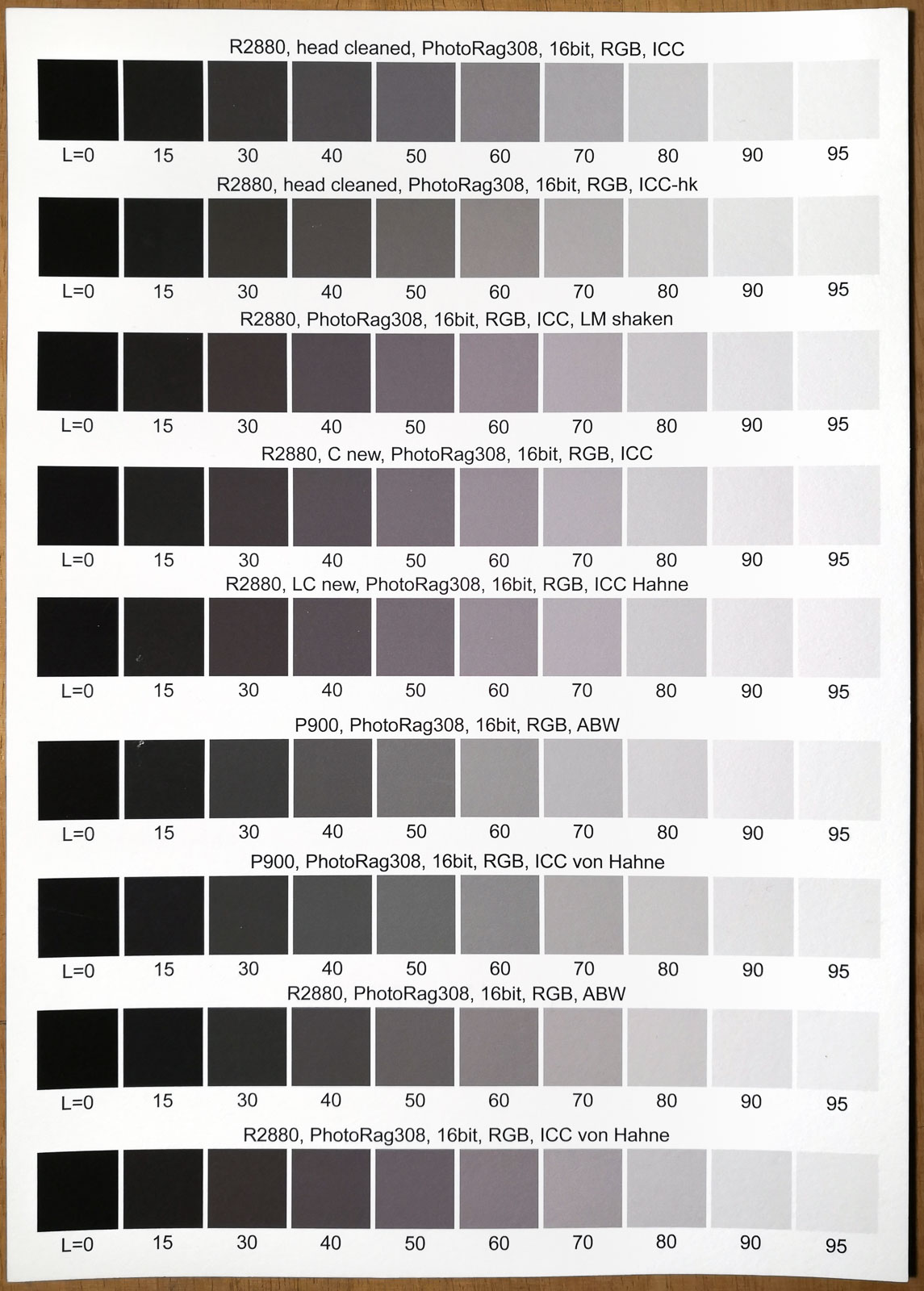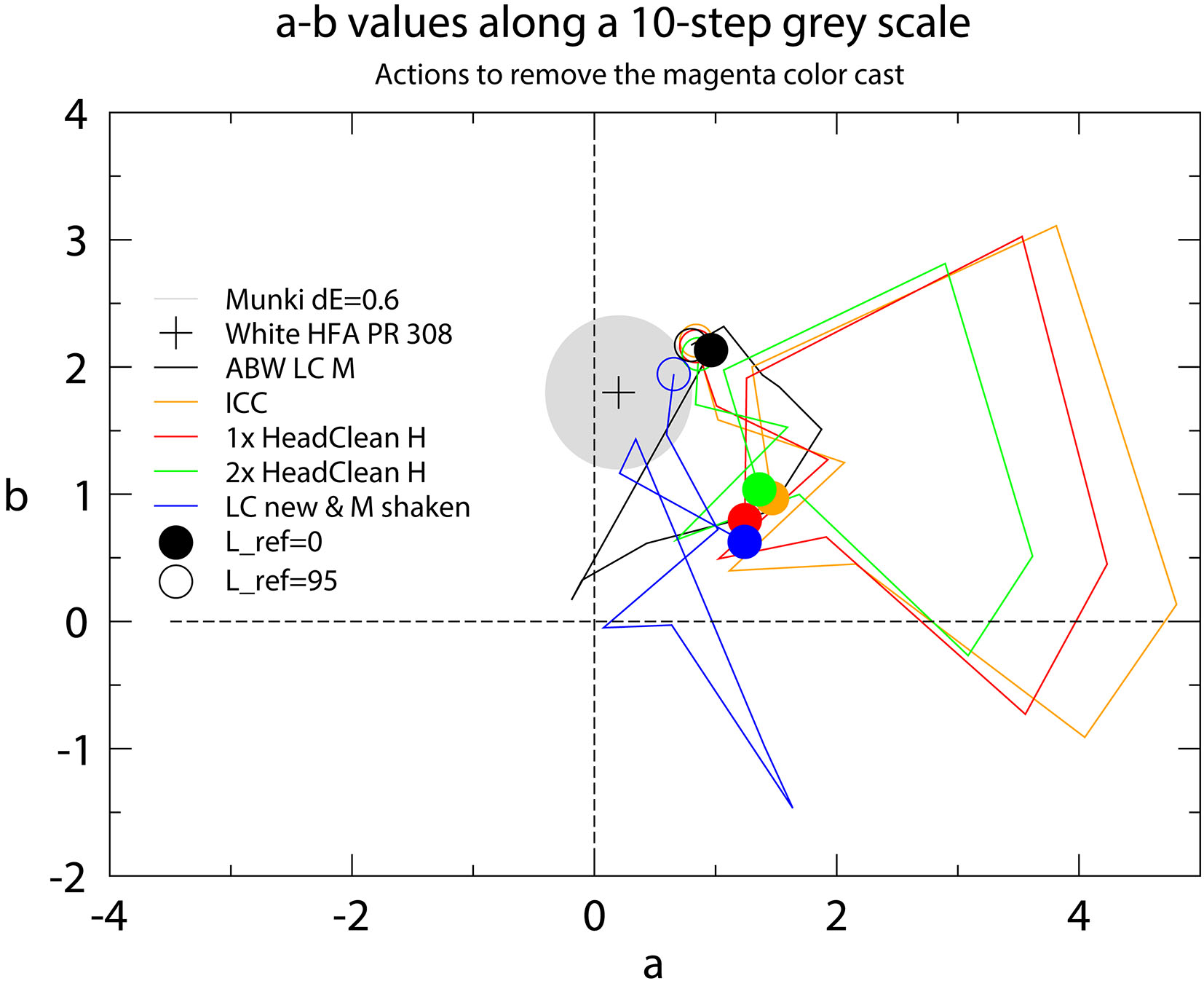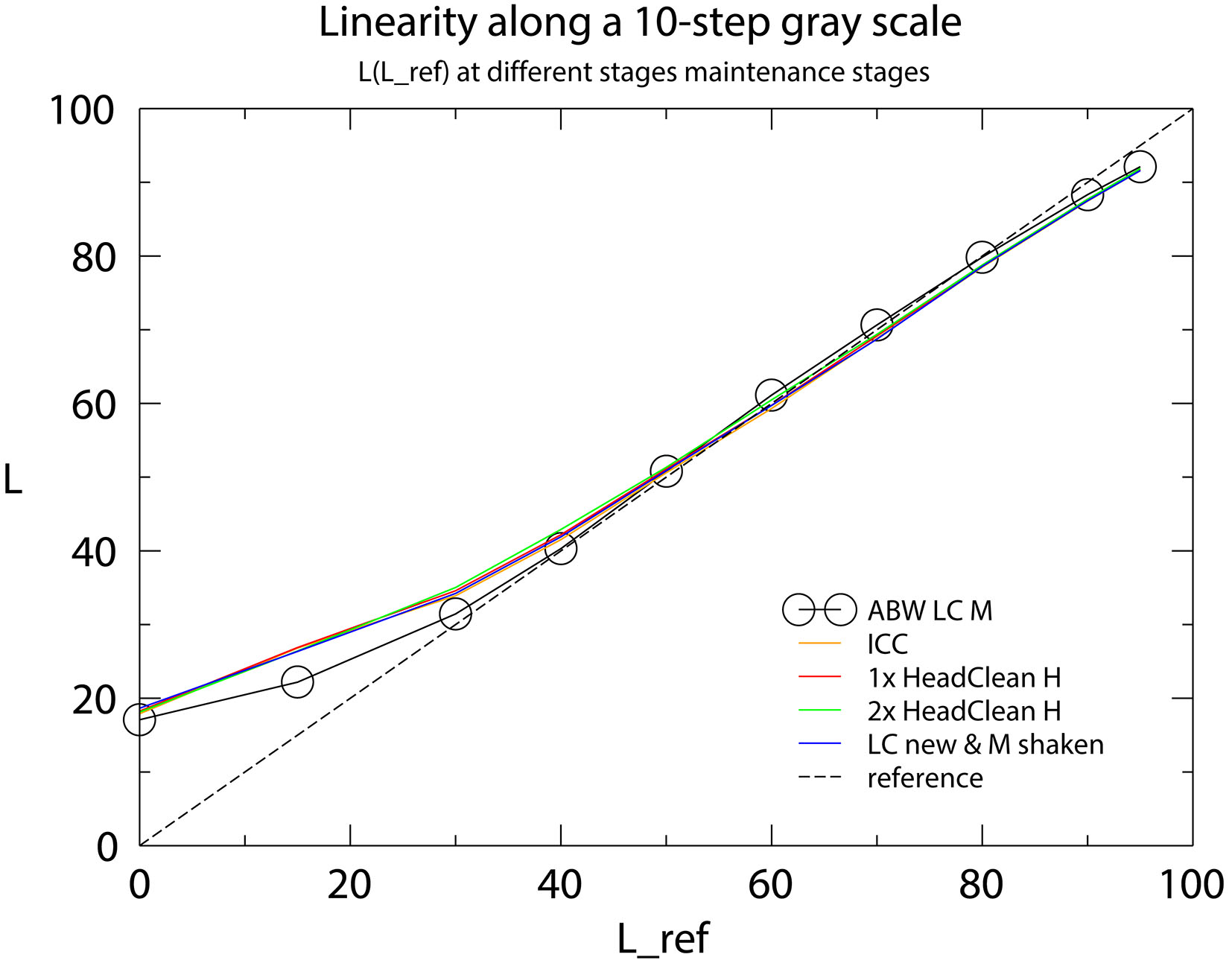
Prints Show a Magenta Color Cast
There are several reasons why prints may exhibit a color cast. In my situation, the prints from my Epson R2880 suddenly started showing a slight magenta color cast. Since I noticed one or two clogged nozzles, I performed an Auto Nozzle Check and Cleaning (C). Following that, the nozzle check indicated that all the nozzles were working properly. Interestingly, the color cast seemed to have appeared right after the apparently successful Auto Nozzle Check and Cleaning (C).
The color cast from the R2880 became noticeable when I compared the same image printed on the Epson P900. To identify the problem, I created a 10-step grayscale (16-bit ProPhotoRGB) and printed this test from Photoshop (on Windows 10) using Hahnemühle Photo Rag 308 paper. The printer drivers used were v6.63 (R2880) and v6.80 (P900). In Photoshop, I set the following preferences: PS Manages Colors, Normal Printing, and Relative Colorimetric. In the printer driver settings, I selected Velvet Fine Art Paper, Color, and No Color Management.
As depicted in figure 1 (photo on the left taken with a smartphone), the grays from the P900 appear almost neutral when using both the ICC profile of Hahnemühle (row 7 from the top) and the printer's ABW mode (row 6). However, in the case of the R2880, a magenta color cast is evident in the mid-tones, especially when using the ICC profiles provided by Hahnemühle (rows 3, 4, 5, and 8, 9). Even when using a custom profile created with a ColorMunki Photo (not shown), similar results were obtained. Switching the R2880 to ABW mode only slightly reduces the color cast. In all cases, the nozzle checks appeared fine (not shown).
To quantify the color cast(s), I measured the printed colors using the ColorMunki Photo. Figure 2 below illustrates the 'a' and 'b' values for the four scenarios: (R2880, ICC, orange), (R2880, ABW, red), (P900, ICC, green), and (P900, ABW, blue), as shown in the lower four rows of the above photo with the gray steps. The 'b' values are plotted against the 'a' values. Along each line, the brightness varies from black (L=0, indicated by the symbols 'x' or 'o') to L=95. The dots indicate the (a, b) values of the measured color for the gray patch with the nominal Lab value (L, a, b) = (50, 0, 0) (refer to the figure above). The most significant color cast occurs in the case of (R2880, ICC), represented by the orange dot, where the color of the patch with the nominal value (L, a, b) = (50, 0, 0) prints as (L, a, b) = (49, 5.4, -1.4). It is evident that deviations from neutrality (a = b = 0) on the order of a = 3 to a = 5 are clearly visible.

The data for the P900 are relatively close to the measured paper white of Hahnemühle Photo Rag 308 (represented by the black dot, Lab=(96,0.2,1.8)). The solid gray disk should indicate the typical error of the ColorMunki Photo (I came across a value of ΔE=0.6).
Here are the steps I took:
- Since the light cyan (LC) ink cartridge ran low, I replaced it. But this did not yield any significant change.
- Then, I reverted back to the earlier driver version 6.62 for the R2880 and shook the light magenta (LM) cartridge, which was still quite full. However, there was no improvement.
- Then I also replaced the cyan (C) cartridge which was consumed up to 20%. This did not lead to any improvement either.
- Subsequently, I performed a Head Cleaning (H) (not the Auto Nozzle Check and Cleaning (C)) and printed the gray scale using my own custom ICC profile (ICC-hk in figs. 1 and 2). This was successful.
- After that, I printed the gray step using the generic Hahnemühle ICC profile, and the result was visibly good as well.
Following the Head Cleaning (H) I measured the gray patches using the generic ICC profile for the R2880 (row 1) and using my own custom ICC profile (row 2). The results are shown as dashed lines in the plot. The custom profile makes slight excursions into the yellow range (violet dashed), while the generic Hahnemühle profile produces a more blue-magenta cast (represented by the orange dashed line). The accuracy of the reproduction of the grays by the P900 with the generic ICC profile is similar to that of the R2880 using my custom profile. As expected, the neutrality is improved when utilizing the Advanced Black and White mode (ABW) of the P900 (blue line). Some deviations from neutrality persist when using the ICC profiles. But these appear to be acceptable considering the color deviation of the paper base from pure white, which is approximately ΔE=2.
In conclusion, the Head Cleaning (H) has resolved the magenta color cast issue to a large extent, despite the initial Auto Nozzle Check and Cleaning (C) seemingly triggering the problem. Most likely I need to print more...
November 2022
Updates


Any broken lines in the nozzle check patterns of the R2880 are usually removed easily. However, owing to infrequent printing (I am mainly using the P900 these days) the color cast returned suddenly, despite of a perfect nozzle check pattern. As can be seen from figure 3, the initial magenta cast (orange line) is reduced by one head cleaning (H) (red line), and further by a second head cleaning (green line). But the progress obtained by repeated head cleanings is slow. After replacing an almost depleted LC cartridge and shaking the M cartridge the color cast has become much less (blue line in figure 3). As expected, the ABW mode yields the best result (black curve), even though some tonal deviations remain.
Figure 4 shows the curves for the Lab value L. While the L values are not much affected by the color cast, the linearity of the curve for the Advanced Black and White Mode (ABW) is much better. The minimum and maximum values of L which can be achieved on Hahnemühle Photo Rag 308 are typical (see the light fade tests of Aardenburg).
March 2024
Due to infrequent use my R2880 also suddenly printed with a greenish color cast (ΔE ≈ 4.5). It was also slightly visible when using the ABW mode (ΔE ≈ 2). In this particular case, repeated head cleanings (H) did not solve the problem. But after replacing the almost depleted light magenta cartridge by a newer one, the color cast partly vanished. Obviously, not enough light magenta had been layed down on the print. It remains a minor bluish cast in the midtones (ΔE ≈ 1.5, a ≈ -1.5). The cyan cartridge is also almost depleted ...
October 2024
